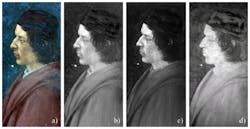Washington, DC--As described in a recent Optics Expresspaper, researchers from the University of L'Aquila, the University of Verona, and Italy's National Institute of Optics in Florence successfully demonstrated a new mid-infrared reflective imaging technique on two famous works of art: the Zavattari frescos in the Chapel of Theodelinda and "The Resurrection" by the Italian Renaissance artist Piero della Francesca. The technique, called Thermal Quasi-Reflectography (TQR), is able to create images using reflected light from the mid-infrared (mid-IR) part of the spectrum (3-5 microns in wavelength) to reveal features not otherwise detectable with the naked eye or current imaging techniques.
Traditional thermography above 3 microns detects subtle temperature differences due to the pigmentation on the surface of paintings. These thermal maps can be used during art restoration to reveal internal defects that are not evident in visible light. But the TQR imaging system is different; it illuminates a painting with a faint mid-IR light source and records the light that is reflected back to a camera.
"This is, to the best of our knowledge, the first time that this technique has been applied on artworks," said Dario Ambrosini of the University of L'Aquila in Italy, one of the paper's authors. All objects emit some infrared radiation and certain materials shine more brightly in one wavelength than in others. At normal room temperature, paintings typically emit more energy in the longer IR wavelengths (42%) than in the mid-IR range (1.1%). To take advantage of this weak mid-IR emission, the researchers applied the basic tools of thermography and ran them in reverse. Since the painting would not normally shine brightly in the mid-IR, the researchers used under-powered halogen lamps as very simple yet effective sources of mid-IR radiation. To measure only the reflected light, special care had to be taken to prevent the lamp from heating the surface of the painting and to exclude all other potential sources of mid-IR radiation.
The mid-IR images are sharper and have better contrast than studies in the far-IR. In its first test on a small section of the Zavattari frescos in the Chapel of Theodelinda, the TQR system revealed details that were missed by earlier optical and near-IR studies. "Our system easily identified old restorations in which missed gold decorations were simply repainted," said lead author Claudia Daffara of the University of Verona. "The TQR system was also much better at visualizing armor on some of the subjects in the fresco."
To further evaluate the potential, the TQR system also studied a painting known as "The Resurrection" by Piero della Francesca. The TQR system identified interesting features, such as highly reflective retouches from previous restorations, all while operating during normal museum hours without interruption. The most surprising feature was an area around a soldier's sword that was painted by using two different fresco techniques. This subtle distinction was not detected by NIR photography.
The researchers are currently conducting tests to determine if the TQR system can also provide IR spectra of the surface of paintings, which may be able to identify the pigments used. "Determining the chemical makeup of the pigments is important in determining how best to protect and restore the artwork," said Ambrosini, noting that TQR may have applications beyond art preservation.
SOURCE: Optics Express; www.osa.org/About_Osa/Newsroom/News_Releases/Releases/06.2012/Art-and-Optics-Converge.aspx
IMAGE:A fresco model, copied from Ghirlandaio, realized around 1930 by the restorer Benini. The images show color photography (a); CMOS Near-IR photography from 0.9 to 1.1 microns (b); IR scanner images at 1.82 microns (c); and a mid-IR TQR image--a mosaic of two views (d).(CourtesyOptics Express)
